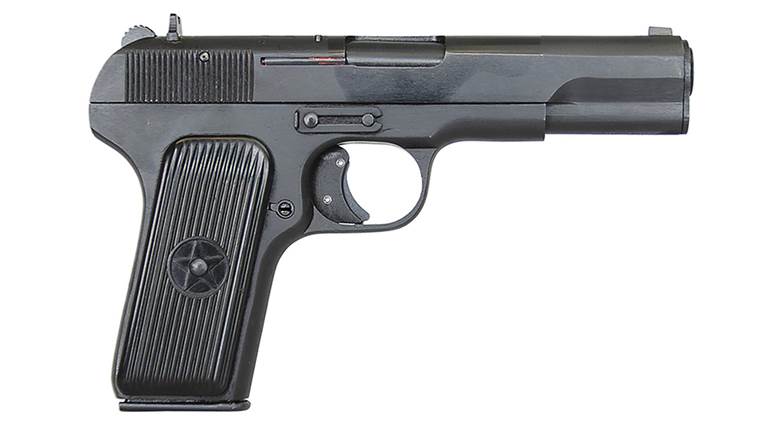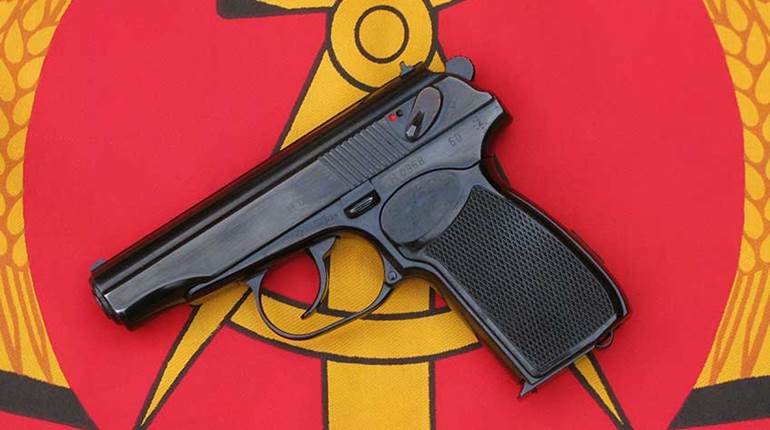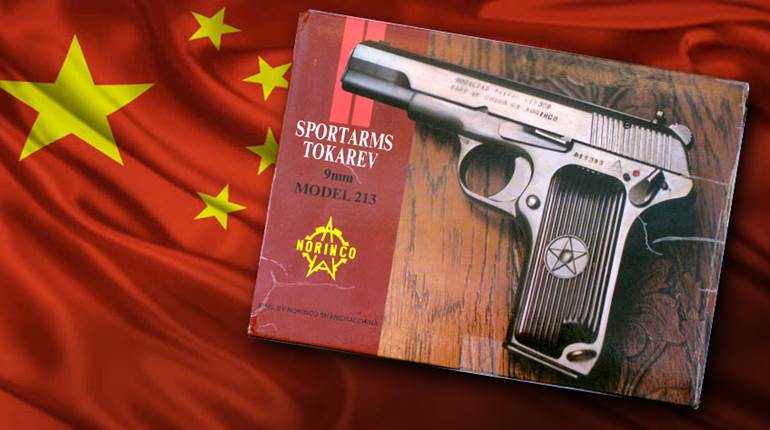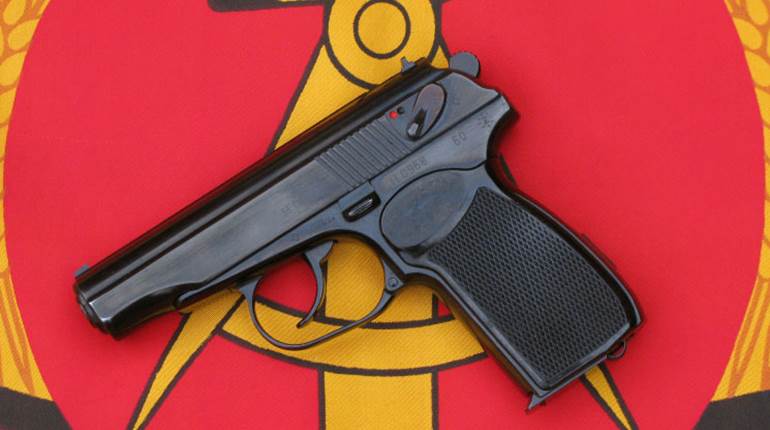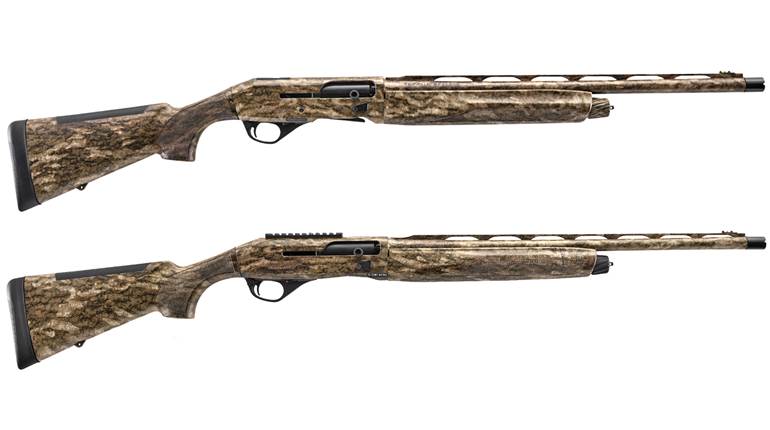
This factory-original box depicts a commercial Norinco Model 213 variant of the Chinese Tokarev. The gun, imported by Sportarms, was chambered in 9 mm Luger and was retrofitted with a frame-mounted safety.
Chinese Tokarev pistols are as interesting as they are ubiquitous. The Tokarev pistol was the brainchild of Fedor Tokarev, a famous Russian small arms designer. Tokarev began the process of designing a semi-automatic handgun in the 1920s, and the Soviets adopted one of his early designs in 1930, naming it the TT-30 (Tula Tokarev 30). The TT-30 was simplified and adopted in 1933 as the TT-33 (Tula Tokarev 33). A simple, reliable and easy-to-maintain pistol, it was in service until the early 1950s when it was replaced by the Makarov (also known as the Pistol Makarova or PM). Several Soviet satellite countries—including Poland, Romania, Yugoslavia and Hungary—adopted pistols styled after the Tokarev.
During the 1950s, China began producing many small arms of Soviet design. Examples of similar arms include the Chinese Type 53 rifle, which is a copy of the Russian Model 44 bolt-action, and the Type 56 rifle, which is nearly identical to the Soviet SKS. China did not have the firearm design infrastructure of the Soviet Union, so it was expedient to adopt existing designs that were both proven and simple to manufacture. Likewise, it was natural for China to adopt a version of the TT-33. The production of small arms in China was also facilitated by a mutual aid treaty between the Soviet Union and China signed in 1950. As part of the treaty, the Soviet Union sent technical advisors and machinery to China, which made the process of arms manufacture easier.
All Chinese Tokarev pistols are the same in terms of form and function as their European counterparts. They are locked-breech, recoil-operated semi-automatics capable of holding eight rounds. They are essentially a simplified version of the John Browning locked-breech design. The pistols are very slender and have good balance. Their profile is different from many Browning designs, because of the sharper grip angle, which gives them a unique appearance. In addition, the hammer is slightly shrouded by the slide. While not a revolutionary design, the guns do have some interesting features; the hammer assembly is particularly well-thought-out. Not only does the subassembly make it easy to inspect the component parts, but the cartridge feed guides are incorporated into its housing, which makes feeding more reliable and less reliant on the magazine feed lips. The pistol has a sturdy magazine that can be disassembled without using tools. The stock panels are held to the frame in an ingenious manner, using sliding bars that fit into recesses in the frame. Tokarevs are often seen with chipped stocks and scratched frames due to improper attempts at stock removal. Interestingly, there is no external safety on the military Tokarevs. The only safety on military pistols is the half-cock notch on the hammer. The firing pin is not of the inertia type, so it is not safe to carry it hammer-down with a round in the chamber. The quality of these pistols in terms of fit and finish is generally excellent.
All military Tokarev pistols are chambered for the 7.62x25 mm cartridge, also known as the 7.62 mm Tokarev. It is based on the older 7.63 mm Mauser cartridge developed by Hugo Borchardt in 1893. The two cartridges have very similar dimensions, but they are not identical. Apparently, the Soviets originally intended to adopt pistols in the 7.63 mm Mauser cartridge in 1929 or 1930, but they intentionally dimensioned the cartridge slightly differently to be able to utilize the 7.62 mm machinery and gauges that were already in use at the time. This simplified Russian arms production since it enabled the same barrel tooling to be used for the Model 1891 Mosin-Nagant rifle, the 1895 Nagant revolver and the Tokarev pistol.
The 7.62 mm Tokarev is a bottleneck cartridge, which aids feeding into the chamber. The bullet weight is typically 85 or 86 grs. It is a hard-hitting cartridge that is generally loaded at high velocities, often 1300 f.p.s. or higher. The cartridge is noted for being very flat-shooting.
Chinese Production: Type 51 And Type 54
The earliest Chinese Tokarev is known as the Type 51. The designation comes from the three characters found on the right side of the frame translated to mean “Type 51.” There is usually a symbol stamped after these characters, which is thought to be an arsenal marking. Other pistols have the number “456” after the characters. Most also have a star stamping after the serial number on the frame, which may also be an arsenal marking. Sometimes, a small triangle precedes the serial number on the slide.
The Type 51 is basically a copy of the TT-33, and it differs only in its markings. It is not clear whether they were made in Russia and sent to China or whether they were made on Russian machinery in China. Type 51s are dated either 1951, 1952, 1953 or 1954 on the left side of the frame after the serial number. The slide, slide stop, hammer assembly and magazine are also serial-numbered. Production numbers are not known, but they are seldom encountered in the United States and most observed specimens are well-worn. Some were captured during the Korean War and brought back as war trophies.

Interestingly, close examination reveals some slight differences within Type 51s. For example, some Type 51 frames have slightly thicker dimensions in the trigger guard area. This is clearly visible when the two different types are placed side by side. The low-relief star emblem on Type 51 stocks can vary in size, shape and profile from pistol to pistol.
The Type 54 superseded the Type 51 at some point in 1954. Even though the Type 51 and the Type 54 are mechanically identical, they differ in their markings, and Type 54s were made completely in China. The three Chinese characters found on the top of the slide are translated to mean “Type 54.” The full serial number is also on the top of the slide. The last three digits of the serial number are found on the barrel, the hammer assembly and the barrel bushing. The last four digits of the serial number are also found on the magazine floorplate.
All Type 54s observed are marked with the number “66” after the serial number, which is believed to be a factory designation. One source states Factory 66 is in Bei’an, China, but another gives a different location. Details about Factory 66 remain a mystery.
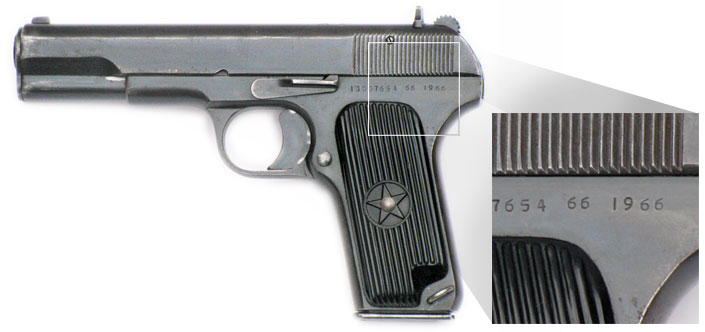
Type 54s often come with a sturdy leather holster that has a compartment for a spare magazine and external loops for a cleaning rod. The holsters are lined with colored corduroy, often blue. The holsters do not have markings to indicate production dates or other information, so it is difficult to determine when a holster was produced and whether it was issued with a given pistol.
The Type 54 was manufactured from about 1954 until 1967, although it is not clear whether it was produced each year. Only pistols dated 1955, 1956, 1959, 1962, 1964, 1965, 1966 and 1967 have been observed. Pistols dated 1966 and 1967 are encountered most often in the United States. None with a date later than 1967 has been reported, although they may exist. Unfortunately, the above conclusions are based only on pistols in the United States, so this sample cannot be considered representative of the total Type 54 production.
Serial numbers occur in blocks of seven or eight digits, with the first digit or the first two digits representing the year the pistol was made relative to the year of adoption. The third digit is almost always a zero, and the actual serial number starts after that. Therefore, a pistol with an eight-digit serial number, such as 13019320, would be pistol number 19320 made in 1966. A pistol with a seven-digit serial number, such as 6013298, would be pistol number 13298 made in 1959. It is worth noting that there appear to be some exceptions to these rules for pistols dated in the early 1960s (e.g., 1962).
Pistols made each year typically started in numerical sequence (i.e. beginning with number 001 after the one- or two-digit date code and the zero). Interestingly, the serial numbers for pistols dated 1967 do not follow this pattern. Based on observed pistols, it appears that pistols made in 1967 have serial numbers that were a continuation of serial numbers from 1966. For example, no 1967-dated pistols have a serial number lower than about 14036000 and no 1966-dated pistols have a serial number higher than about 13032000. Thus, it appears that the serial numbers for the 1967 pistols picked up somewhere in the 32000 to 36000 range where the 1966 numbers ended. The reason for the continuation of serial numbers for these two years is not known.
Below are serial number ranges by year for guns reported/observed (note that only years with multiple examples reported are notated below):
| Year | Low | High | Estimated Production |
| 1964 | 11097XXX | 11112XXX | 12,000 |
| 1965 | 12003XXX | 12087XXX | 9,000 |
| 1966 | 130008XX | 130316XX | 32,000 |
| 1967 | 140364XX | 140922XX | 57,000 |
| Total Estimated Production, 1964-1967 | 110,000 |
It is very difficult to determine how many pistols were actually produced in total, although one would assume the number to be large since they were also used by the Chinese army. The current status and location of Chinese military pistols is not known. It is possible that stockpiles of pistols remain in storage in China or perhaps some were destroyed.
The M20
The M20 is another interesting variation. This pistol differs from the Type 54 in that it does not have the Chinese characters on the top of the slide. Rather, the slide is marked “M20” along with the serial number. It does not have the year of manufacture or “66” marked on the frame as do the Type 51 and 54, so it is not possible to determine when and where these pistols were made. The stocks on many do not have the characteristic star on them. Rather, they have a plain circle where the star typically is found. It may be that the mold for the stocks was modified to remove the star or perhaps standard stocks were individually ground to remove the identifying star marking. Some have also been observed with standard military stocks or, more rarely, wooden stocks, but these are probably replacements. It is generally believed that the M20 was a sanitized version of the Type 54 and was intended for clandestine use or for export. It is not known how many were produced. Nonetheless, they do show up for sale from time to time so there are a number of them in the United States.
It appears that at least two distinct blocks of serial numbers were used for the M20 with some having seven digits and others six digits. The serial number on all M20 pistols starts with an “N” followed by the serial number, most commonly starting with 11 or 12. A few pistols, though, have six-digit serial numbers that start with an “N“ followed by “0” followed by the rest of the serial number. If the same serial number system applies to these pistols as with other Chinese small arms, then the pistols with serial numbers beginning with 11 were made in 1964 and those starting with 12 were made in 1965.
A few examples of unmarked early production Type 54 pistols have been observed. One has the thicker frame that is seen on some Type 51s. The serial number on observed specimens starts with either a 2 or a 3, indicating they were probably produced in 1955 and 1956. What makes these pistols unique is that they lack the Chinese characters and date stamping that is found on other Chinese military pistols. The serial number on the frame and slide are the only external marking. The history and use of these pistols is not known. This variation has not been described previously.

Wartime And Commercial Use
Surprisingly, very little is actually known about the distribution and use of the Type 51 and Type 54 in the Chinese military. Period photographs are virtually unknown and sources in English are quite limited, thus reliable information is hard to come by.
China apparently supplied the North Vietnamese with a significant number of Type 54s that were used in the Vietnam War. Most Chinese military Type 54s in the United States were captured during the war and were brought back by returning servicemen. The Type 54 was a coveted war trophy. Some pistols have the “capture” paperwork with them, which firmly establishes their provenance. Many pistols show blue wear and pitting due to the effects of the humid climate. However, bores are typically in excellent condition since most are chrome-lined.
Many Chinese Tokarevs were imported into the United States from the late 1980s until about 1994 when the importation of some arms from China was banned due to sanctions. Pistols were imported by several different companies including China Sport Industries (CSI, Ontario, Calif.), Navy Arms Co. (NAC, Ridgefield, N.J.), B-West (Tucson, Ariz.), K Sports Imports (KSI, Pomona, Calif.), Sportarms (Miami, Fla.), ACC Int./Intrac (Knoxville, Tenn.) and Interstate Arms Corporation (IAC, Billerica, Mass.). The CSI and NAC pistols are most commonly encountered. These pistols were priced very reasonably, and many were sold.
A few of the first pistols imported appear to have been military pistols that were converted for commercial sale by changing markings and adding an external safety to the slide or the frame. The safety was required for the pistols to be imported under the Gun Control Act of 1968. A few early pistols even have the Chinese characters on the top of the slide, which clearly indicates the part came from military production lines or inventory. Some have the Factory 66 marking by the serial number, but others do not.
Later pistols, especially those chambered in 9 mm Luger, appear to have been newly manufactured for the U.S. market. These do not always look the same as the military pistols. For example, the slide serrations are often angled as opposed to being perpendicular. Some slides and frames have slightly different contours.
A large number of variations of commercial Chinese Tokarevs exist. Navy Arms offered several distinct models. For example, some were sold as “dual-caliber” (7.62x25 mm and 9 mm Luger) guns that came with a spare barrel and magazine. Others had wraparound grips. A few had a chrome or satin finish that was hoped to appeal to U.S. firearm buyers. Some magazines had magazine floorplates with finger extensions.
The commercial Tokarevs were only made in 7.62x25 mm and 9 mm Luger, although a few aftermarket barrels were made in .38 Super. The magazines for some 9 mm Tokarevs were made differently to accept the shorter cartridge, and some pistols had an insert added to the frame to accommodate the smaller magazine.
The most common commercial model is the Norinco Model 213 in 9 mm Luger. The Type 54-1 pistols, which were in 7.62x25 mm, were not as popular with U.S. buyers. One especially interesting variation is the Model 213A chambered in 9 mm, which has a wider frame to accommodate a wide-body, higher-capacity magazine that resembles the Browning High Power magazine. Most pistols came in a foam box with a light cardboard outer box, but some had a plastic carrying case, and may have a cleaning rod and a spare magazine.

Despite the many configurations, there seems to be limited collector interest in commercial Tokarevs. Many do not like the added safety and the import markings, which change the appearance of the pistol. Collectors often erroneously view Chinese-produced guns as poor quality so they overlook them, however, there are some real bargains to be had given the wide number of variations produced.
Enduring Popularity
Unlike the lukewarm interest in commercial Chinese Tokarevs, military versions of the guns enjoy great popularity within a select group of American collectors and shooters. Collectors like the multiple variations of the pistols and their connection to the Vietnam War. Shooters like the pistol because of its sleek, unencumbered design and the fact that they are reliable and easy to maintain. The 7.62x25 mm cartridge is appealing because it shoots well. The large number of military and commercial Chinese Tokarevs speaks to the soundness of its basic design. Even though the Tokarev design is more than 85 years old, it remains iconic due to its classic lines, simplicity and reliability.












